The Blood Red Parrot Cichlid is a peaceful, hybrid fish, identifiable by its bright orange color and distinctive shape. Suitable for intermediate aquarists, they require a minimum 30-gallon tank with specific water conditions and a well-balanced omnivorous diet. They are prone to certain diseases and live up to 15 years. Their behavior and compatibility with other fish make them a popular choice for community tanks.
Table of Contents
Blood Red Parrot Cichlid : A Quick Summary
The blood-red parrot cichlid (Hoplarchus Psittacus) is a species of fish native to South America. It is known for its bright red color and distinctive, parrot-like beak. It is a popular fish in the aquarium trade and is known for its peaceful temperament and ability to adapt to a variety of environments.
The blood-red parrot cichlid can grow to a maximum length of about 12 cm and is a popular choice for community tanks.
Blood Red Parrot Cichlid Overview
The Blood Red Parrot Cichlid, a hybrid species developed in Taiwan during the 1980s, is known for its peaceful nature and suitability for community tanks. Resulting from breeding Convict Cichlids with Red Devils, Midas, Red Heads, or Gold and Green Severus, it is recognizable by its round body, beak-like head, and large eyes. Despite initial controversy over ethical breeding concerns, it has become a popular aquarium fish.
This species was created by breeding Convict cichlids, Red Devils, Midas, Red Heads, or Gold and Green Severus. The hybrids can easily be recognized through their unique features—round body and beak-like head with large eyes.
Their mouths stay open in a continuous “O,” and their teeth are deep down in their throats, so they cannot fight and would rather bump into each other.
If you consider adding some character to your fish tank, these small fishes are an ideal addition. Besides their unique and characteristic features, their compatible nature makes them easy to maintain and singly in species and community tanks.
This guide will walk you through all the basics you need to know about the blood-red parrot cichlid and how to take care of them.
| Information Chart | Blood Red Parrot Cichlid |
| Scientific Name | N/A |
| Family | Cichlidae |
| Care level | Intermediate |
| Temperament | Peaceful to semi-aggressive |
| Color | Bright orange |
| Lifespan | 10-15 years |
| Size | Up to 8 inches |
| Diet | Omnivore |
| Minimum tank size | 30 gallons |
| Temperature | 76°F to 80°F |
| Water conditions | Freshwater with open space |
| Tank mate compatability | Peaceful |
Blood Red Parrot Cichlid Appearance
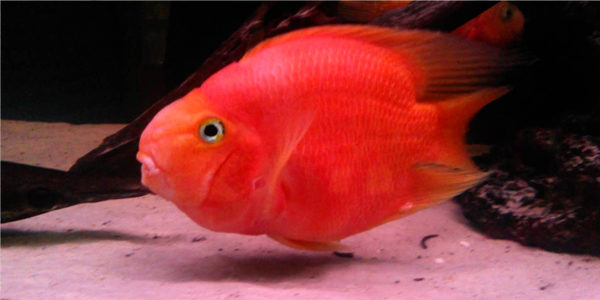
The blood-red parrot cichlid is hybrid fish and has a beautiful appearance. The adults generally grow up to 8 inches, which is comparably a lot larger than some of the other cichlids.
As for their structure, these fishes have a round body, large googly eyes, and wider fins, giving them a larger appearance than the other fishes in the community tank.
They get their characteristic name from the color of their body, which is bright orange and stands out when you place them in the home aquarium. The bright orange is spread across the entire body, mostly solid but with patchy remnants around the remaining area.
Some of the other hybrid blood red parrot cichlids feature yellow and bright red colors on their bodies. Some commercial aquarists might use dye to brighten their color, but that can lead to shortened life span and premature death.
However, one distinctive feature in these blood red parrot cichlid species is that their mouth doesn’t close completely. It is due to a genetic anomaly that happened after extensive hybridization.
Lifespan of Blood Red Parrot Cichlid
The typical lifespan of a blood-red parrot cichlid is between 10 to 15 years. This is a lot more compared to the other cichlid species that you find in the market.
However, the only issue with raising a blood-red parrot cichlid in captivity is that determining their standard lifespan is difficult. Generally, the same depends on their living conditions and how they are raised in captivity.
Besides your efforts, even the practices of the commercial breeder affect the lifespan of the fish. Any kind of artificial modification to their appearance will alter their lifespan dramatically.
Blood Red Parrot Cichlid Size
The typical blood-red parrot cichlid typically grows up to 7-8 inches in captivity. The average size can be less than 7 inches in the female variants. The male counterparts are generally longer in size.
The female blood red parrot cichlids are shorter in size; they also have a round and plump body, while the male ones have a sleek and slender shape.
There are very few rare blood-red parrot cichlids that can grow up to 10 inches, but that is just a handful and often an anomaly from the breeding practices.
Natural Habitat and Origin
The Blood Red Parrot Cichlids are part of the Cichlidae family and a pretty new hybrid fish species. Although the aquarists have a hard time pinpointing the parent species, in particular, experts suggest that they are generally a blend of Midas and Redhead Cichlids.
That reflects on their longer lifespan if you keep them under the right living conditions. One common mistake that several beginner aquarists do is confuse them with saltwater Parrotfish, which can be life-threatening if you don’t provide the parrot cichlids with the ideal water conditions.
Generally, the care and origin follow similar parameters as the Central American Cichlid fishes because both their parent fishes are from the same family. Although they first originated in the 1980s in Taiwan, they sparked a lot of controversies surrounding them.
Many aquarists protested against further cross-breeding because it is unethical. This stopped people from selling the hybrid fishes to interested customers. However, people have overcome the controversies ever since then, and it has become one of the most popular bred Cichlid species fish in the market.
Blood Red Parrot Cichlid Care and Tank Set-up
Here we focuses on the specific needs of these hybrid fish. It covers optimal tank size, water parameters, tank landscape, and filtration requirements. The section emphasizes the importance of creating a comfortable and healthy environment for these fish, considering their unique characteristics as hybrids.
Blood Red Parrot Cichlid Tank Size and Specifications
The parrot cichlids don’t have a “native” habitat because they are a hybrid species. Since it is a product of hybridization, we’d recommend that you follow the care instructions provided by the breeder so you can help them live a healthy and comfortable life.
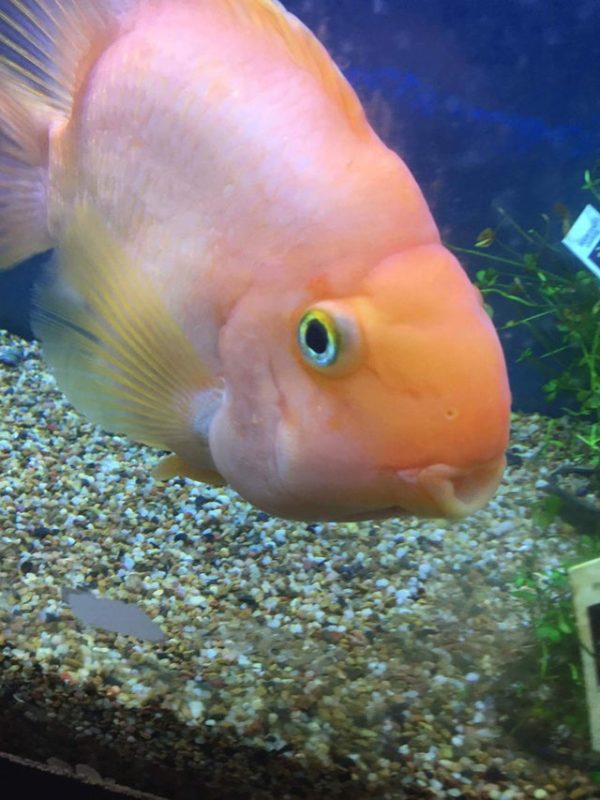
Since these fishes are hybrids and have been bred in captivity since the beginning, taking care of them might not be the easiest for beginners. This is why they are often a suggested species for the intermediate aquarists. Although they don’t demand super-specialty care, they have some specific requirements that need to be met.
Let us start with the specific tank requirements first.
Optimal Tank Size for Blood Red Parrot Cichlids
The minimum tank recommended for a Red Parrot is 30-gallons, with an additional 10-gallons for every other one. Of course, no tank can be overly large, as they need plenty of swimming space.
Despite their “larger” size, these fishes are comparatively a lot more active than the other cichlids. Try not to keep them singly because they will eventually get bored in the tank without company.
So, if you are keeping them in a species tank or a community tank, make sure that you keep 1-2 parrot cichlids paired with a few other compatible species.
Providing good filtration is imperative, as these cichlids produce a lot of waste.
Filter Type
Comparing their size and the kind of food they gobble down every day, it isn’t surprising that the blood-red parrot cichlids produce a lot of waste. This can seem imperative initially, but if you aren’t cleaning the tank frequently (every few days), you need to rely on a good-quality and high-power filtration system to get rid of the waste and keep the water clean.
Even if you can’t change the water at least once a week, make sure you do so once every two weeks. As for the filter that you integrate into the tank, find the ones that will create a heavy stream of water current to enable a comfortable movement for these fishes.
Substrate
Although the blood-red parrot cichlids aren’t necessarily bottom feeders, they zoom around the entirety of the tank. This means that you will find them swimming in the middle and sometimes going to the bottom to dig through.
So, adding a smoother and smaller sandy textured substrate in the bottom is key. However, make sure that you avoid putting any kinds of rough substrate because that will harm them and impose risks of cuts and infections.
Avoid adding larger rocks or hard edges gravel as a substrate because that will injure them badly, even proving fatal for them. If they are extremely hungry, they can venture down to the bottom of the tank and dig through the substrate for food, but that is quite rare.
How many Blood Red Parrot Cichlids in 30 gallon tank?
If you are starting with a 30-gallons tank, we’d recommend keeping one in it. However, if you plan to keep at least two, increase the tank size by 10-gallons more, and you should be set.
Water Parameters for Blood Red Parrot Cichlids
Nine out of ten times, aquarists set up their home aquarium for a specific fish species depending on how they are in their natural habitat. Since the blood-red parrot cichlids result from hybridization, maintaining their water parameters requires special care.
So, in such conditions, the best way to take care of them is to follow and set up similar water parameters like their parent species. Since they predominantly belong to the cichlid family, the aquarists follow similar water parameters as needed by the Midas Cichlid.
Besides the slightly moderate water temperature, these Central American fishes also prefer a mildly acidic water condition throughout the year, so make sure you provide them with the ideal surroundings for optimal growth.
Water Temperature
The ideal water temperature for Blood Red Parrot Cichlid is 76°F to 80°F. Try to maintain the temperature between that range to offer them a comfortable and energetic lifestyle.
pH Level
The perfect water pH level for Blood Red Parrot Cichlid is 6.5 to 7.4, which is a mildly acidic environment, as we said before. Try to check the pH level every few days because the ammonia from their waste can alter the pH now and then.
Water Hardness
The ideal water hardness for these freshwater fishes is between 6-18 dGH.
Blood Red Parrot Tank Landscape
Since these fishes don’t have an origin or natural habitat that they are used to living in, they will adapt to any kind of tank environment that you introduce them to.
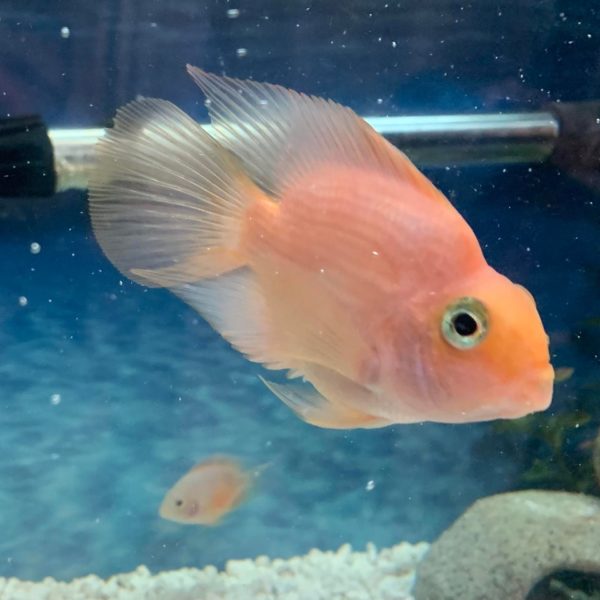
From live plants to artificial ones, they mesh well with every setting without any issues. However, there are a few important factors that you need to look out for when you are setting up the tank to house a blood-red parrot cichlid.
The most important part of their tank landscape has to be safer hiding spots. Although they are quite active fishes, they like their downtime now and then. You will often find them hiding and shying away when they get tired and just relaxing in the tank.
If there aren’t enough hiding spots, it can eventually put them under a lot of stress, which will compromise their lifespan. So, integrate multiple hiding spots with the following additions in the tank:
As for lighting in the tank, you want to keep things dimmed and subdued. Blood red parrots don’t like highly exposed lights and rely on the red spectrum from the white light. So, a soft standard aquarium tank light will get the job done just fine.
Besides the lighting and decorations, be mindful of the filtration too. Integrating a high-power filter into the tank is an absolute must.
Feeding Blood Red Parrot Cichlid
Blood Red Parrot Cichlids thrive on a varied diet including pellets, flakes, and live or frozen foods like bloodworms and brine shrimp. Their meals should be small and frequent, tailored to their unique mouth shape and dietary needs. Overfeeding should be avoided to maintain water quality and fish health.
Blood Red Parrot Cichlids are omnivores, which means that they will gobble down anything that you feed them – vegetables or meaty foods.
A well-balanced diet is a key to having healthy fish, besides keeping water in good condition.
They especially love freeze-dried, frozen, and live food, but brine shrimp should only be given as an occasional snack. As a base diet, you can feed them high-quality flakes or pellets formulated for cichlids.
Live feeder fish can also be fed, with guppies being a suitable feeder fish, and avoid goldfish at all costs. Still, it may not be such a good idea to constantly bring in new fish, as they may bear infections or illnesses that may affect your established tank.
Given their misshapen mouths, owners must make sure they are indeed fed, as this makes it hard for them to compete for food.
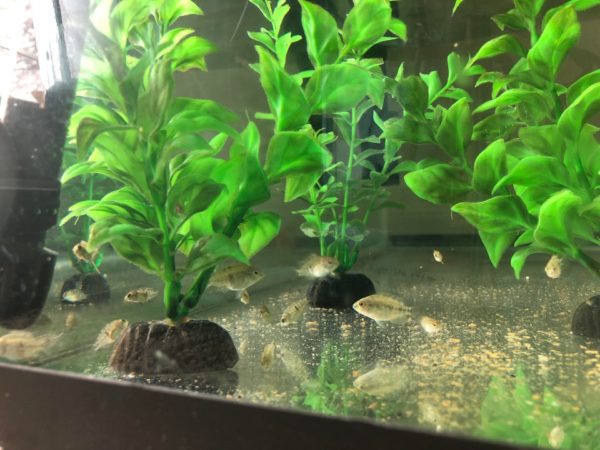
Also, the parrot cichlids have a hard time feeding on the tank’s surface, which means flakes aren’t the best food choice for them. Instead, rely on pellets that can sink to the bottom. There is a range of dried foods available in the market that are specifically formulated for the Cichlids. Those work the best for their diet.
Since they are hybrid fishes with bright-colored bodies, feeding them a nutritious diet is key to their longer lifespan. As for treats, items like daphnia, brine shrimp, and bloodworms are some of the best choices. However, don’t overdo the portion of treats or even the frequency you feed them.
Despite their size, these fishes will eat even when they are full and satiated. So, limiting their feeding up to twice a day is considered ideal. If they are hungry, they will venture down to the bottom of the tank and dig through the substrate to look for food items.
Also, make sure that you feed them as much they can complete within 1-2 minutes. Anything more than that can result in overfeeding and cause them distress.
Blood Red Parrot Behavior and Temperament
Blood Red Parrots like privacy; thus, many clay pots and caves are a must in their tank. They are very peaceful and playful fish that have a nice interaction between them and with other fish swimming around.
They recognize their owners and come to greet them at the front of the tank. Many aquarists recommend the Blood Red Parrots for large community tanks with peaceful yet active set-ups.
Don’t be blindsided though because these bright orange-colored fishes can show signs of aggression. So, if you find them out of the loop and showcasing different behavior than what they normally do, it is a sign that they are under stress and might show signs of aggression against the other fishes that they feel threatened to.
They can also become territorial if they don’t have enough space around in the tank. So, your main aim in housing a blood-red parrot cichlid in the tank is to provide them with enough space to move around. If their movements are restricted or inhibited by other fish species, there can be signs of attacks and fin nipping in the tank.
The blood-red parrot cichlid generally sticks to the middle of the tank while swimming around the tank. On rare occasions, you will find them moving to the bottom of the tank near the substrate to find food.
Blood Red Parrot Fish Tank Mates
Suitable tank mates for the Red Parrot Cichlids are usually younger Oscars, Severus or other peaceful cichlids of the same size, like Flag cichlids or Fire mouths.
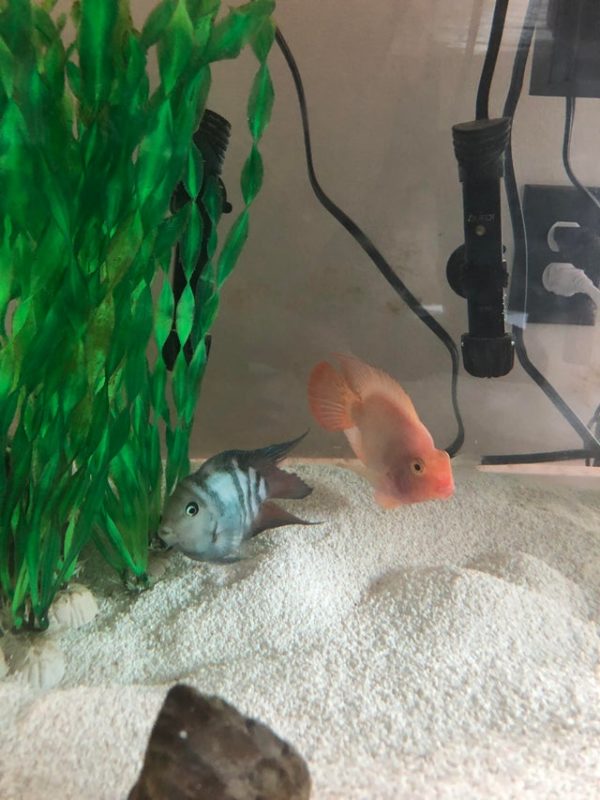
Other companions include angelfish, silver dollars, or Bala sharks, with some catfish, plecostomus, and loaches also accepted and even ignored.
See that the community tank is large enough, or the Blood Red Parrots become territorial and seek to harass other fish.
Keep an eye on your community tank from time to time, as the Red Parrots are descendants of aggressive parents. Despite this, they are usually shy and peaceful fish, but may develop a mean streak.
Besides a community tank, they also stay well in a species tank with other blood parrot cichlids. If you don’t want to complicate things, this is your best choice. Although they can live singly, staying in groups or a school helps them exhibit better confidence and feel safe in the tank.
When putting these red parrot cichlids in the community tank, your main concern is to never pair them with smaller fishes that they might mistake for food. Also, keep them with peaceful fish species that like to keep to their business and don’t create chaos in the tank.
Some of the best tank mates for Blood Red Parrot Cichlid include:
- Emperor Tetra
- Honey Gourami
- Yoyo Loach
- Firemouth Cichlid
- Tiger Barb
- Clown Pleco
- Dwarf Gourami
- Kribensis Cichlid
Breeding of Blood Red Parrot Fish
As they are hybrid fish, they mate with other non-hybrid fish such as Convicts, Severus, and Midas but do not produce any offspring when bred within the species.
The female can lay eggs, but they cannot be fertilized by the male, so non-hybrid fish males are necessary to help perpetuate the species.
The male blood parrot cichlids aren’t able to fertilize the female ones due to infertility. Breeding two blood parrot cichlids are thus impossible or extremely difficult. Some breeders try to increase the male red parrot cichlid’s fertility using hormone therapy, but the outcomes aren’t always favorable.
Once the female fishes lay the eggs on smoother surfaces like plants or rocks, both the female and the male parents guard the eggs and take care of them till they hatch. However, if any of the eggs develop fungus over them, they will eat it up.
If you consider breeding a female parrot cichlid, maintaining the ideal water temperature and parameters is crucial. Crank up the temperature to 80 degrees Fahrenheit and clean the water before the breeding process.
Once the fry hatches successfully, you can remove the parent fishes to the primary tank and take care of the smaller offspring yourself. Make sure that you change 25% of the water daily to provide them with optimal living conditions without any risks to their health. Also, brine shrimp is the ideal feeding option for the newly hatched fry.
Blood Red Parrot Cichlid Diseases and their Treatment
Lack of properly ample hiding places, together with poor water quality, exposes the Blood Red Parrots to great stress, which will affect their immune system. The first illness they are exposed to is Ich, which thrives on vulnerable fish, helping it spread.
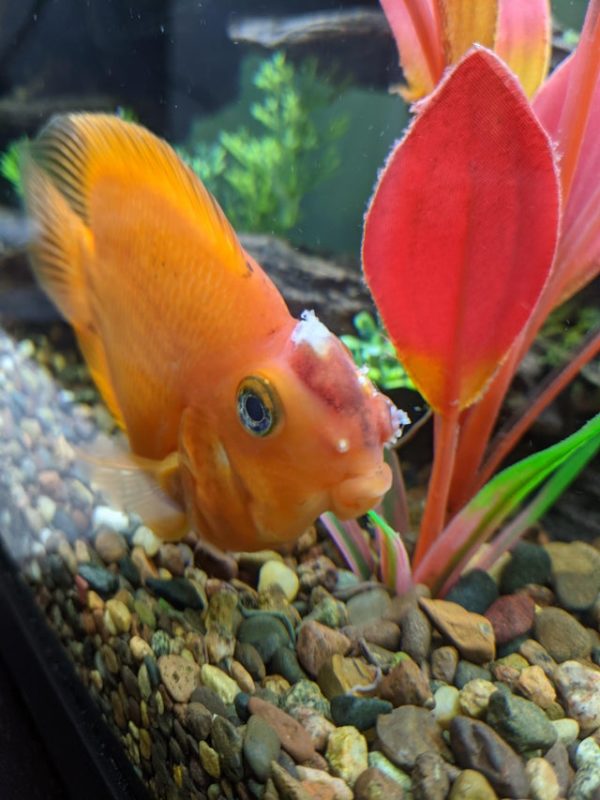
If you notice any signs of Ich, higher the aquarium temperature gradually until reaching 86° Fahrenheit and keep it at this point for three days. If this does not work, you can treat the Ich with copper-based chemicals, but make sure there are no water conditioners left.
They are also prone to Swim Bladder issues due to a poor diet and can develop Stress Spots when sudden changes occur in the tank, or the fish are being bullied, stressed, or ill.
Other common health issues are parasitic or bacterial infections or skin flukes.
Are Blood Red Parrot Cichlids Right for You?
Adding a hybrid fish to your home tank is a lot of effort and commitment. So, if you are convinced to get them just because of their appearance and the beautiful look, you are setting yourself up for a challenge.
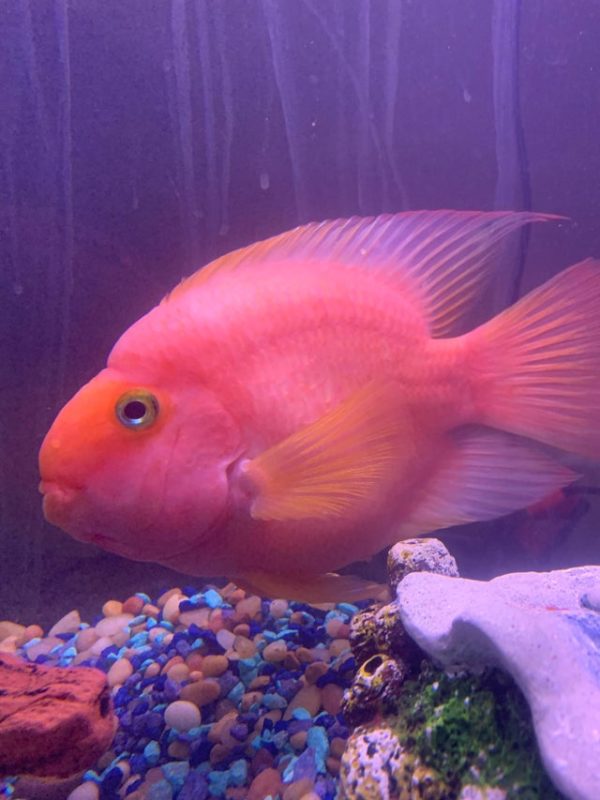
These fishes don’t require expensive setup or care, but their life is unpredictable, especially if you can’t gauge their temperament and body language in the new tank.
Besides that, adaptability, as an aquarist, you need to keep their tank environment clear and devoid of their waste and rising ammonia levels because that further puts them under stress. Also, don’t force-breed them among themselves because that doesn’t happen as easily as the other cichlid species.
FAQs
What kind of fish can you put with blood parrots?
Peaceful and non-aggressive, and non-territorial fishes are considered ideal for blood parrots. However, make sure that you don’t keep them in a community tank that houses smaller fishes because the red parrot cichlids can mistake them for food.
Why is my Red Parrot fish always hiding? How do I stop it from doing so?
Red parrot cichlids love their alone time and have a habit of hiding when they are tired or feel overwhelmed in the tank. If they are doing it now and then every day, it is a normal thing for them. However, if they are not active and spend all their time hiding, it is an alarming sign, and you should seek help from the breeder you got it from.
How do I stop my red parrot fish from picking on each other?
If you find your red parrot cichlid picking or other fishes, it is likely a sign of aggression. Normally, lack of space or territorial behavior causes them to act out like that. So, the best way to combat that is by separating the aggressive fish to a different tank for the time being.
How long can parrot fish go without food?
Red parrot cichlids have a habit of overeating even when they are full. So, if you find their abdomen swollen or they don’t venture down to the bottom of the tank much for good, the chances are that they are full. Sometimes, they can even go a day without food; however, we’d recommend feeding them regularly.
Why is my blood parrot fish turning black?
The appearance of black patches on the blood parrot fishes’ bodies is due to altered environmental factors. It can be due to stress, unknown injuries, or even the elevated ammonia levels in the tank due to it not being cleaned for a long time.
How do I treat black spots on my parrot fish?
If you are noticing black spots on the body of your blood parrot fish, it is important that you immediately identify the cause. If it is due to ammonia levels, change the water and clean the tank. However, if it is due to an injury, you might have to put down the fish to give them a comfortable death where they aren’t in pain.
Conclusion
Now that you know a bit more about blood red parrot cichlid size and their lifespan, do you think they would be a good addition to your home aquarium? The thought of owning a hybrid fish can be daunting, if not extremely challenging. But, once you know the parameters and the care guide, all you have to do is follow them religiously to ensure the fish has a comfortable life.
Also, when getting a blood parrot cichlid for your tank, make sure you get them from reliable breeders with a good name in the market. The last thing you want is to end up getting a diseased fish that has been bred under the wrong circumstances.

16 thoughts on “Blood Red Parrot Cichlid: Care Guide, Breeding & Tank Size”
My parrots are a beautiful bright orange within hours of doing a water change but then turn an ugly pale color after that. All levels are correct. How can I get them back to bright orange?
You need to make sure that your fish is eating. the same happens to me when my parrot fish doesn’t like a certain food
I have been raring fish for last 9 months my fishes both parrrot and Oscar have grown well and died shudden, I have canister filter also
Please advise
I just got 2 juvenile blood parrots they won’t eat the pellets I try and feed them and one just sits in the corner by the heater due to the fact the other one buluies him into the corner how can I fix this they are 3days in
They do better in groups of 3 or more or as singular fish. A pair will usually not work as they are always trying to bully each other or the more aggressive one will torment the other one. When in groups of three or more this seems to stop. But you must have at least a 55gal or preferably larger tank for 3. Hope this helps and good luck!
Most fish require a minimum of three. It reduces the aggression. Two males or two females will try to assert dominance, one Male and one female will mean the Male will bully her to try to reproduce. Keep one or a minimum of three.
I have 3 blood red parrot fish and 2 of them are bulliny one it’s been 4 days in how can I fix this
I’ve had my blood red parrot for 8 yrs now. She is turning a lighter color & has some black on her back fins. I dont know what it is. Can anyone help?
Blood parrots will develope black markings on the body or fins when stressed. They will subside on their own when the stress is eliminated. I thought they were sick when i first experienced this, but after years of dealing with them ive learned to avoid it.
Can you feed red parrot cichlids tropical flakes.
I have a 37 gall tank and I have only 1 pair of BP, 1 pair of African Chidlit and 1 pair of Tin foil barb. is it ok to keep only one pair of BP or should i add another pair of BP
You already have too many fish for a 37 gallon tank. My female parrot is 4 years old and she is 7 inches.
do blood parrot fish like to play in sand?
I have small pebbles,
I had a 80L tank filled with tetra, gourami, angel fish and a few cleaners (shrimp & suckers) I was sold an Blood Parrot at my local pet shop Without knowing the size of tank he would need. He grew to kill all of my fish by literally beating them to death and swallowing the smaller ones whole. I bought him a bigger tank at 160L and added bigger/tougher fish before adding him but he killed those too. I’m now looking to give him a 300L tank as he’s still growing after 4yrs but I would like to have more than one fish in that size of tank. I can’t even put live plants in as he likes to redecorate and eat them. I’ve always been so proud of my community tanks and growing my own plants from cuttings is there anything I can do to get my beautiful tank back? I’ve read they are very friendly fish, am I doing something wrong? He has a small ish cave, tall plastic pants to swim through and A collection of plastic plants that I’ve organised to act as a cave/cover. I had a mixture of sand, small stones and slightly bigger stone for the base in the first tank he liked to pick up the larger stones and move them about so I used them as the ground covering in the current tank. Also I’m finding it hard to get hiding places big enough for him, any ideas? Thanks for reading, hope someone can help?
Well After reading your comment I really want to know how is everything as of today.
I have a very healthy active Parrot Cichlid who eats everything from flakes, shrimp.pellets, fresh spinach, canned peas, even bottom feeder pellets. He is a bit territorial but not to the point of being overly aggressive. He also has a great personality and would definitely recommend them.